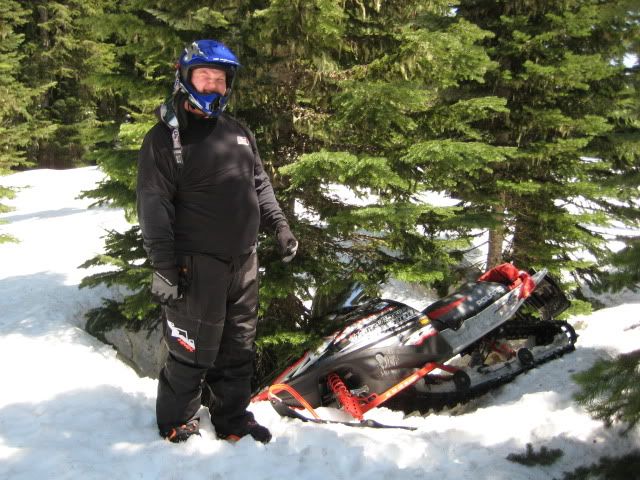I was talking with a fellow the other day that was telling me bout a story where he lost his sled near 5 feet deep in one! Found the risks of these mostly to skiers but presents a geniune risk to us as well. Here is some info that surprised me a little. Also anybody have some good pics they can post?
Prevention of falling into a tree well is all-important because the odds of surviving deep snow immersion are low. For your safety, you should assume all trees have a hazardous tree well.
In an experiment in which 10 volunteers were temporarily placed in a simulated tree well, none could rescue themselves.
Experts who chart skiing injuries have documented a significant risk: suffocation after falling, often headfirst, into deep snow depressions around trees (tree wells) or even on open ground. Most tree well incidents have occurred at ski resorts in the western United States and Canada, though the same risk would be present wherever deep powder conditions are found.
Fortunately, the risk of falling into a tree well is completely avoidable. Unlike avalanches, which are difficult to predict and the danger is often not visible, tree wells exist in deep snow areas and only around trees – in simple terms, a tree well is a hole in the deep snow, which is clearly marked by a tree.
You can avoid falling into a tree well by avoiding skiing or snowboarding near trees in deep snow areas.


WHAT IS A TREE WELL:
Hazardous tree wells are generally found in ungroomed areas.
The low-hanging branches of trees may create a sheltered area around the base of the tree, where a well of loose snow with air pockets can form.
It is best to assume that all trees in deep snow have some depth of tree well. Usually there is no easy way to identify if a particular tree has a dangerous tree well by sight, because the branches often block visibility of what hole may exist.
Particularly hazardous trees appear to actually be the smaller trees or trees where the branches are touching the snow. The branches help form a canopy over the hole, inhibiting snow from filling in the hole around the trunk of the tree –thus the snowpack increases outside the branches, creating a deeper hole under the branches.
The risks are greatest during and after major snowstorms. The amount of snow piled up on the outside of the branches can also add to the hazard, because this snow is knocked off of the branches and down into the hole when hit, this could possibly contribute to a burial.
Tree wells tend to form on the downhill sides of trees, because snow on the uphill side tends to creep downward and become compacted against the tree. Once again, branches touching the snow might effect this.
Tree wells are also more common in areas sheltered from the wind, because strong winds break up snow crystals, increase snow density and blow snow around to help fill in the hole/well.
Prevention of falling into a tree well is all-important because the odds of surviving deep snow immersion are low. For your safety, you should assume all trees have a hazardous tree well.
In an experiment in which 10 volunteers were temporarily placed in a simulated tree well, none could rescue themselves.
Experts who chart skiing injuries have documented a significant risk: suffocation after falling, often headfirst, into deep snow depressions around trees (tree wells) or even on open ground. Most tree well incidents have occurred at ski resorts in the western United States and Canada, though the same risk would be present wherever deep powder conditions are found.
Fortunately, the risk of falling into a tree well is completely avoidable. Unlike avalanches, which are difficult to predict and the danger is often not visible, tree wells exist in deep snow areas and only around trees – in simple terms, a tree well is a hole in the deep snow, which is clearly marked by a tree.
You can avoid falling into a tree well by avoiding skiing or snowboarding near trees in deep snow areas.


WHAT IS A TREE WELL:
Hazardous tree wells are generally found in ungroomed areas.
The low-hanging branches of trees may create a sheltered area around the base of the tree, where a well of loose snow with air pockets can form.
It is best to assume that all trees in deep snow have some depth of tree well. Usually there is no easy way to identify if a particular tree has a dangerous tree well by sight, because the branches often block visibility of what hole may exist.
Particularly hazardous trees appear to actually be the smaller trees or trees where the branches are touching the snow. The branches help form a canopy over the hole, inhibiting snow from filling in the hole around the trunk of the tree –thus the snowpack increases outside the branches, creating a deeper hole under the branches.
The risks are greatest during and after major snowstorms. The amount of snow piled up on the outside of the branches can also add to the hazard, because this snow is knocked off of the branches and down into the hole when hit, this could possibly contribute to a burial.
Tree wells tend to form on the downhill sides of trees, because snow on the uphill side tends to creep downward and become compacted against the tree. Once again, branches touching the snow might effect this.
Tree wells are also more common in areas sheltered from the wind, because strong winds break up snow crystals, increase snow density and blow snow around to help fill in the hole/well.












